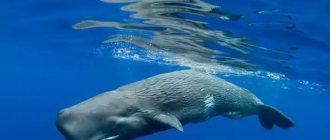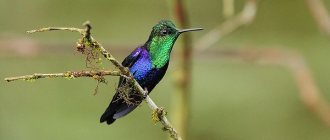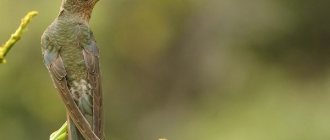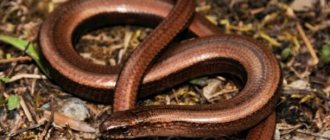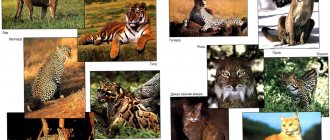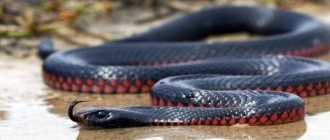When we are told about the class of cephalopods, octopuses are the first to come to mind. Typical representatives live at the bottom of the water, but some of them inhabit the high layers of seas and oceans. This inhabitant of large waters has always caused surprise among ordinary people, since it has a ball-shaped body, long tentacles, a specific nose and great intelligence.
Interesting!
Many people were interested in the question of how many hearts an octopus has. A small number of animals have three “engines of life”. Science includes all known species in the order of these cephalopods, from the smallest to colossal specimens.
Origin of the species
Scientists cannot say exactly when the first octopuses appeared. Since their torso contains no bones and only soft tissue, over time their body completely decomposes, leaving no traces.
However, in Lebanon, scientists discovered the remains of a cephalopod, which were preserved inside fossilized soil.
Research has shown that they are 95 million years old! And what is most surprising is that in size and structure the remains completely coincide with living octopuses. This suggests that over such a huge period of time the creations have not changed in any way. Interesting fact : there are suggestions that the most ancient representatives of the octopus species had shells like snails, but this has not been proven.
Interesting Facts
Description of the octopus
Octopuses move along the bottom
Octopuses are the most numerous species of cephalopods. They are divided into two subspecies, differing in their lifestyle: nomadic and benthic. The former live in one territory, the latter regularly move underwater in search of more favorable conditions.
They are exclusively underwater creatures and cannot live on land. Their outer shell needs constant moisture and quickly dries out in the air.
8-Is it true that there are immortal jellyfish on Earth?
There are types of immortal jellyfish. According to scientists, they can only die from illness or injury. To date, there is only one species that has been called "biologically immortal": the jellyfish Turritopsis dohrnii. These small, transparent animals live in oceans around the world and can turn back time to an earlier stage in their life cycle.
A jellyfish's new life begins with a fertilized egg, which develops into a larval stage called a planula. After swimming quickly, the planula snaps onto a surface (such as a rock, the ocean floor, or the hull of a boat), where it develops into a polyp: a tubular structure with a mouth at one end and something like a foot at the other. It remains in place for some time, turning into a small colony of polyps that share feeding tubes with each other.
Appearance
Octopuses do not have a neck or body, so the tentacles grow directly from the oval head. The mouth is located in the very center of the lower part, at the convergence of all the limbs. The waste ejection hole is located behind the head.
Structure of an octopus
There is a membrane between the tentacles, and they also have from one to three rows of suckers. The latter are needed in order to hold the prey and prevent it from swimming away. The octopus literally sucks food to itself and gradually moves it to the mouth.
Interesting fact : octopuses have a total of up to two thousand suction cups on their tentacles, which can hold an object weighing up to 200 kg.
Since their body does not contain bones, octopuses are able to take any shape. They can completely lie flat on the bottom, like a piece of paper, or curl up into a perfectly shaped ball.
Most individuals are pink-brown in color, but they are also capable of changing their color like chameleons. This allows you to blend in with your surroundings and become invisible to other creatures.
Size
The standard length for males is 1.3 meters, for females - 1.2 meters. It is measured taking into account the tentacles, but the body of the mollusk can be from 30 to 50 cm long. Weight reaches 10 kg, but most specimens weigh from 5 to 7 kg. As you can see, there is no air of impressiveness here. Legends about giant octopuses were written in ancient times, when people did not have the opportunity to take a closer look at this harmless creature.
Interesting! The largest octopus is the rock octopus. A mollusk with a tentacle length of 3.5 meters and a weight of 58 kg is officially registered in the Guinness Book.
For a quiet life, he needs rocky shores, where he can take refuge in one of the natural caves. Having no skeleton, the octopus easily fits into any hollow niches and crevices, hiding from predators and resting in them during the day.
Peculiarities
The octopus' tentacles are covered with suction cups.
The octopus has many features that allow it to adapt to its surrounding conditions. Since it is impossible to create a vacuum in water, the cephalopod's suckers cannot work as well as their human-made rubber counterparts. Because of this, the creature has to control them by tensing the muscles on the tentacles. A person makes such an effort. when trying to suck in air or liquid through the mouth.
An octopus has three hearts. Moreover, one is used for the functioning of the circulatory system, and the other two are needed for the normal functioning of the respiratory system. The creatures' blood is blue. Some species are capable of emitting poison, and among octopuses there are individuals that are considered the most poisonous creatures on Earth.
Interesting: Why does the wind blow from the sea to the land during the day, and vice versa at night?
Octopuses come in a variety of sizes. Some individuals can grow to just a couple of centimeters, while others can boast dimensions of several meters. Doflein's octopuses are especially famous in this regard: one individual grew to nine and a half meters and weighed 270 kg.
How do octopus hearts work?
The heart is a muscle that contracts at a certain speed in order to carry blood to all cells of the body. The main inconvenience in the structure of the mollusk is that its gills are endowed with too much resistance. Nature found a reasonable solution and endowed the cephalopod with three heart muscles to increase the utility coefficient.
The main heart has a large volume , and the other two, located near the gills, are somewhat smaller. All three muscles beat synchronously, and the frequency of the beat depends on the temperature of the water. Cold reduces the number of beats per minute. Blood is blue because it contains the enzyme hemocyanin with copper impurities.
Where does the octopus live?
Octopuses often settle in rock crevices.
The creatures live in seas and oceans, and they try to find areas with warm waters, since cold waters make them more drowsy. As a lair, the octopus prefers dark places where it is easy to hide from unwanted eyes. This could be a dark bottom at great depth, a gap in a rock, or a hole in a sunken ship. The easier it is to become invisible in this environment, the better.
Interesting fact : sometimes octopuses can use an empty shell as a temporary lair, pretending to be a crustacean.
Most often, cephalopods do not descend to a depth of more than 150 m, but sometimes people have discovered them by sending special survey equipment several kilometers down.
Habitat
Octopuses are not too fond of cold waters. Therefore, they practically do not live in the northern oceans and seas. But the rest are precisely the main habitat of most representatives of the cephalopod class. In nature there are both deep-sea and shallow-sea species. The comfortable depth of the places where octopuses live is on average about 150 m. Since the lifestyle of mollusks is sedentary, they are quite attached to their chosen “place of residence,” which is usually bottom rocky areas, piles of stones and coral reefs.
What does an octopus eat?
The octopus chose two shells.
These creatures are predators and are capable of digesting any creature found in the depths of the sea. They feed on fish, shellfish, crustaceans and even their own kind. Octopuses do not have developed feelings of loyalty and sympathy for their fellows, so in times of hunger they can easily eat a smaller octopus without any problems. There have even been cases recorded when large individuals attacked sharks, and the latter could not cope with them.
The principle of predator hunting is quite simple. It lies on the bottom, merging with its surroundings, and waits for prey to swim past. Then he suddenly rushes at her and digs in with his tentacles. Having completely wrapped its limbs around the food, the octopus stuffs it into its mouth. There are no teeth in the throat, but it is hard and ribbed, which helps grind pieces into porridge.
Sometimes a predator misjudges the situation and attacks fish that are too large. The latter can fight back and eat the offender herself or deprive him of a pair of tentacles. But cephalopods experience virtually no pain, and their limbs quickly regenerate.
2-There are numbers below zero
For adults, this is, of course, not a revelation. But for preschoolers this may come as a surprise. As you understand, we are talking about negative numbers, which a preschooler learns about only after several years of schooling.
Talk about these amazing numbers and you will see that you will introduce your preschooler to the real magic of numbers. There is no need to wait for the child to learn about this years later in mathematics lessons. Believe me, your child may be interested in this today.
Color
Octopuses can change color
An octopus can change skin color depending on the circumstances. He does this with the help of special pigment cells located on the upper shell. When you need to “repaint” your body a certain color, the nervous system sends a special impulse that causes them to shrink or stretch, which is why the desired shade appears.
Interesting fact : when an octopus is scared, its shell turns white, and when it feels angry, it turns red.
Video
And finally, an interesting documentary about octopuses from National Geographic.
Author: Pavel Chaika, editor-in-chief of Poznavaika magazine
When writing the article, I tried to make it as interesting, useful and high-quality as possible. I would be grateful for any feedback and constructive criticism in the form of comments on the article. You can also write your wish/question/suggestion to my email [email protected] or Facebook, with respect, the author.
Author page
Features of character and lifestyle
Octopuses can be considered nocturnal creatures. During the day they prefer to sleep in their shelters, and at nightfall they go out to hunt. They are inactive and slow, and do not like to leave their territories.
Octopuses can swim by making powerful thrusts with their tentacles, taking in and releasing water with their mouths, and moving head first. However, they do this reluctantly, because... feel vulnerable during this process. At this moment, they are easy to grab from any side, so octopuses prefer to move along the bottom and rocks, clinging to the surface with suction cups.
Interesting: Is it possible to determine the age of fish?
Octopuses are very clean. If there is debris or algae around the home, they will definitely put them in a separate pile and sweep the space around with their tentacles.
Nutrition
Octopuses, however, like other cephalopods, are predatory creatures; their diet consists of a variety of small fish, as well as crabs and lobsters. They first capture their prey with their tentacles and kill them with poison, then they begin to absorb them, since they cannot swallow whole pieces, they first grind the food with their beak.
Social structure and reproduction
A small octopus hatched from an egg.
Octopuses lead a solitary lifestyle and do not flock together. Each individual has a territory with clear boundaries, and if an outsider crosses them, a fight will definitely take place, during which only one will survive.
When it comes to giving birth to offspring, the female herself goes in search of a male. She does this twice a year. After meeting a male octopus, she goes with him to a secluded place, where up to 80 thousand eggs are born. From that moment on, the female does not leave the shelter and takes every possible care of future children. The male is helping his friend at this time. However, the mother always experiences a lack of food, so during this period it is very difficult for her.
After four months, small larvae emerge from the eggs, which are immediately carried away by the current and feed on plankton. They grow quickly, and after a few months they already weigh more than a kilogram. However, not all manage to survive to adulthood, as they become food for fish and other underwater creatures.
3- Who can run longer: a man or a horse?
Humans can run longer than any animal. The latest scientific evidence confirms that humans are the world's best runners.
In 2007, in the journal Sports Medicine, Harvard evolutionary biologist Daniel Liberma and University of Utah biologist Dennis M. Bramble wrote that several characteristics unique to humans suggest that endurance running plays an important role in our evolution.
Don't mammals run faster than humans? After all, having four limbs gives most mammals an advantage. Yes it is. But this is true when it comes to short distances. But when it comes to long distances, humans can outrun almost any animal. Because we cool down by sweating rather than panting, we can keep our bodies cool at greater speeds and distances.
For example, in mammals, at high speeds and distances, the body, as a rule, overheats greatly. According to scientists, on a hot day a person can outrun a horse in a 42-kilometer marathon.
Natural enemies of the octopus
Sharks are one of the main enemies of the octopus.
Since they lead a predatory and aggressive lifestyle, octopuses have many enemies. They sometimes end up in the mouths of large sharks, seals, sea lions, killer whales and other large fish.
However, when a cephalopod encounters potential danger, it has several trump cards that help it avoid a skirmish. Octopuses are capable of releasing purple ink into space, which completely disorients the offender. While the enemy is trying to understand what happened, the octopus quickly disappears into a nearby crevice and hides there.
The creation is also characterized by autotomy. If an enemy grabs it by the tentacle, it detaches it like a lizard's tail and calmly swims away. Scientists have long established that octopuses have high intelligence, which is why they can make the most logical and correct decisions in stressful situations. Cephalopods are also capable of solving simple riddles involving opening valves and moving objects.
Interesting fact : sometimes a predator is its own enemy. Some octopuses exhibit autocannibalism, during which they can eat their own tentacles, even experiencing slight hunger.
How do they reproduce?
In most octopuses, reproduction occurs only once: having given birth to offspring, they die from exhaustion.
Cephalopods mate in the following way: the males release spermatophores into the mantle cavity of the female, inserting a sexual tentacle, the hectocotylus, into one of the siphon openings. The fluid released by the male enters the female's oviduct and fertilizes the eggs during laying.
Sometimes females, after mating, strangle their partner with tentacles. They drag dead males into their lair and eat them. In species with developed intersexual cannibalism, males try to stay as far as possible from the female, extending the hectocotylus to a length twice the length of the tentacles. Some species of molluscs detach their completed sexual tentacle and leave it to the female.
Females hide the laid eggs in holes, glue them to the walls of crevices and caves, or glue them into small clusters and carry them with them. All the time before the hatchlings appear, they monitor the eggs, remove any debris that gets on the clutch and direct streams of fresh water towards them. The duration of egg maturation varies from 4-5 months to a year or more in some species of deep-sea mollusks. All this time the female does not hunt or eat. Octopuses are born completely independent.
Why is the octopus called that?
There are two versions of why the octopus is called that way. The first guess, which is the most logical, is that it has eight legs. And during pronunciation, the voiced consonant “v” gradually dropped, which is why the word began to begin with the vowel “o”. The second theory for the appearance of the name is based on the anatomy of the cephalopod. Its limbs are arranged in a circle, along the edges of the lower part of the head. Thus, they form an axis, which, in combination with the word “leg,” gives rise to the corresponding name.
5-Why do we see distant stars in the sky?
We see a star in the night sky due to the fact that a small particle of light, called a photon, is repelled from the star and, having traveled a huge distance of space and time, reaches our eyes
Because of the finite speed of light, when you look into the night sky, you are looking into the past. The bright star Sirius is 8.6 light years away. This means that the light hitting your eyes has been traveling for 8.6 years. In other words, when you look at Sirius tonight, you will see him as he was 8.6 years ago.
As you look at more distant objects, the effect gets bigger and bigger. The stars of Ursa Major are between 60 and 125 light years away.
When you look at the star Dubhe (the leading star in the bowl of Ursa Major), you see light that was created before you were born.
Is octopus dangerous for humans?
Octopuses are not dangerous to humans.
The creature is practically not dangerous to humans. It is very cowardly and would rather run away than fight. Only very large individuals will try to fight back, but people can easily cope with them.
Interesting fact : when it sees a threat, the cephalopod is able to quickly swim away, reaching speeds of up to 15 km/h.
Poisonous octopuses pose the greatest danger. They use poison only in extreme cases, when the enemy has a tight grip on them. If a person receives an injection, he may experience swelling and dizziness, which will soon go away. The exception is Australian individuals, which have particularly strong poison. Their injection can lead to the most tragic consequences.
Interesting: Moon fish



